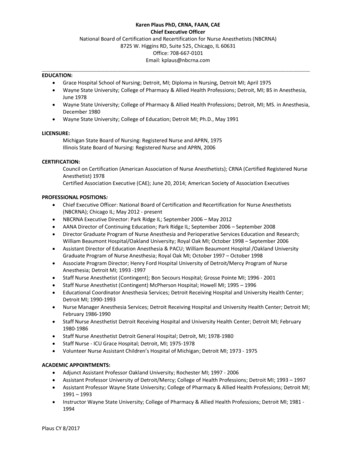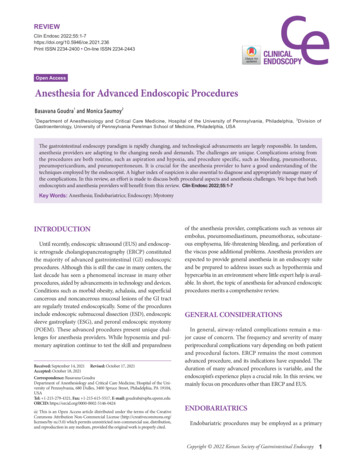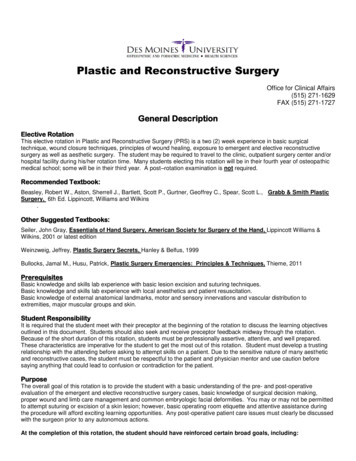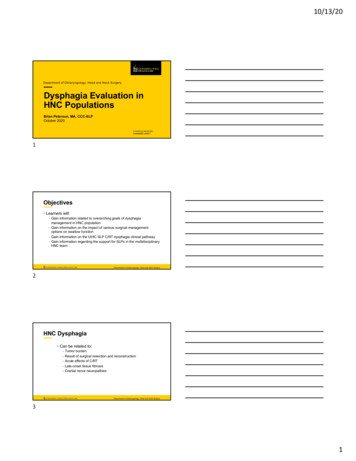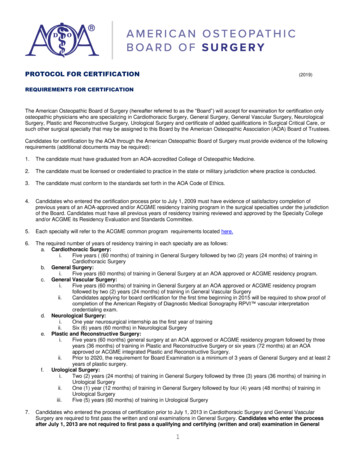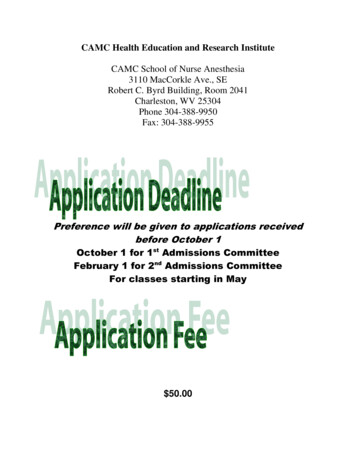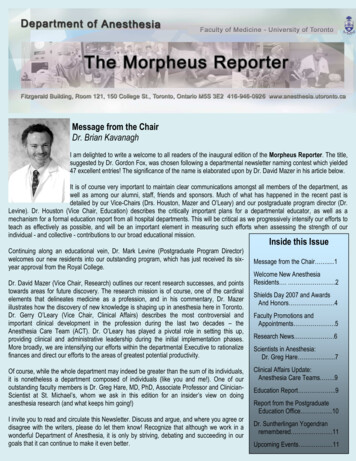
Transcription
Preoperative EvaluationJason Ryan, MD, MPH
Preoperative Evaluation Detect unrecognized diseaseEvaluate factors that increase risk of surgeryPropose strategies to reduce this riskAdverse outcomes of surgery: DeathMyocardial infarctionRespiratory failureHeart failureArrythmias (atrial fibrillation)BleedingWikipedia/Public Domain
Types of SurgeryOpen Heart Surgery Non-cardiac surgery Cardiac surgery CABG Valve replacementPublic Domain
Preoperative Evaluation History and physical examBlood tests: CBC, chemistriesEKGCardiac stress testChest x-rayPulmonary function tests
Preoperative EvaluationCardiac Risk Evaluation Adverse cardiac outcomes of surgery Myocardial infarction, arrythmia, cardiac arrest Risk increased based on: Patient factors Surgical factors Calculators: estimate risk of cardiovascular complications Based on procedure and patient factorsGupta MICA NSQIP database risk modelRevised cardiac risk indexNSQIP universal surgical risk calculatorNeedpix.com
Preoperative EvaluationCardiovascular Assessment History and physical exam Acute coronary syndrome or acute heart failure Treat or stabilize ACS or HF prior to surgery EKG Usually done prior to surgery Not absolutely necessary in completely healthy patients If no evidence of ACS or HF proceed to surgery No stress testing or other cardiac testing indicated One exception: elective vascular surgery
Preoperative EvaluationStress Test Major decision in elective surgery: stress test? May identify critical coronary disease In theory, revascularization may reduce risk of post-op MI Little data showing benefit of revascularization before surgery Stress test only indicated before elective vascular surgery in select patientsShutterstock
Preoperative EvaluationElective Vascular Surgery AAA repairFemoral-popliteal bypassCarotid endarterectomySurgery can be safely delayedPre-operative stress test sometimes indicatedStress Test Only if patient functionally limited Only if patient has risk factors Only if abnormal result with change managementWikipedia/Public Domain
Preoperative EvaluationElective Vascular Surgery Unable to perform 4 METs of activity Climb stairs Walk up an incline Patient must be high-risk (3 or more risk factors) Indications for pre-op stress test Elective vascular surgeryPatient unable to perform 4 METsHigh risk patientAbnormal result with change managementMajorRisk FactorsCADHFCVADiabetesCr 2.0Age 70
2014 ACC/AHAGuideline onPerioperativeCardiovascularEvaluation andManagement ofPatients UndergoingNoncardiac Surgery
Coronary Stents Dual antiplatelet therapy (DAPT) after implantation Aspirin plus clopidogrel/ticagrelor/prasugrel Reduces risk of stent thrombosis Recommended DAPT duration: 6 to 12 months After 6 to 12 months: lifelong aspirin (81mg)Coronary Stent
Preoperative EvaluationCardiovascular Assessment Recent ( 6 months) coronary drug-eluting stent implantation Dual antiplatelet therapy recommended for 6 months Discontinuation of DAPT associated with stent thrombosis Consider delay surgery or perform on DAPTWikipedia/Public Domain
Preoperative EvaluationCardiovascular Assessment Remote ( 6 months ) coronary DES implantation Discontinue antiplatelet therapy prior to surgery Restart after surgeryCoronary Stent Special case: bare metal stents Lower risk of stent thrombosis May discontinue DAPT after 1 monthWikipedia/Public Domain
Preoperative EvaluationCardiovascular Assessment Recent acute coronary syndrome Delay surgery until 60 daysAnterior ST-elevation Myocardial Infraction
Preoperative EvaluationCardiovascular Assessment Most cardiac conditions do not prohibit surgery Coronary artery diseaseCardiomyopathyHeart failurePrior cardiac arrest
Preoperative EvaluationCOPDPulmonary COPD Optimize prior to surgery No prohibitive level of pulmonary function Asthma, obstructive sleep apnea Optimize prior to surgeryJames Heilman, MD/Public Domain
Preoperative EvaluationPulmonary Cigarette smoking Current smokers: increased risk post-op complications Quitting before surgery may reduce risk Chest x-ray Not routinely done unless specific indication Pulmonary function testing Not routinely done unless specific indicationPatrick Lynch/Wikipedia
Preoperative EvaluationLiver Disease Surgery usually acceptable for patients with cirrhosis Child Pugh class Points for encephalopathy, ascites, bilirubin, albumin, PTClass assigned based on pointsClasses A and B lower riskHighest risk class C MELD score Point system using bilirubin, creatinine, INR Estimates 3-month mortality MELD Score 15 higher riskShutterstock
Preoperative EvaluationHematology High risk of bleeding with low platelets or coagulopathy Goal platelets: 50,000 Normal platelet count: 150,000 to 450,000/μL Bleeding risk usually not increased unless 50,000 Goal INR 1.5 Normal INR 1.0 Bleeding risk increased INR 1.5 Goal Hgb 7 g/dL (hct 21) Adverse outcomes below this levelPublic Domain
Preoperative EvaluationSurgical Indications Emergency surgery Risk of forgoing surgery extremely high Very little role for preoperative evaluation Classic example: traumaWikipedia/Public Domain
Preoperative EvaluationSurgical Indications Urgent surgery Risk of prolonged delay is high Hip fracture, malignancy Brief delay only for urgent treatment (MI, HF) Elective surgery Delay of surgery acceptable Time to optimize patient Extensive pre-operative testing possiblePublic Domain
Preoperative EvaluationAnticoagulants and antiplatelets Warfarin Hold 4-5 days before surgery Goal INR 1.5 Heparin drip Half life 60 to 90 minutes Discontinue hours before surgery LMWH Last dose 24 hours before surgery Last dose 50% normal dose Aspirin, clopidogrel, ticagrelor, prasugrel Discontinue 5 to 7 days before surgeryPublic Domain
Preoperative EvaluationOther drugs ACE inhibitors and ARBs May cause hypotension through RAAS activity Usually held morning of surgery NSAIDs Inhibit platelet function Avoided 1 week prior to surgery Oral contraceptive pills May increase risk of post-op thrombosis Hold if surgery high risk for post-op DVT/PE Beta-blockers and statins: continuePixabay.com
Preoperative EvaluationOther drugs Oral hypoglycemic agents Sulfonylureas, thiazolidinediones Hold morning of surgery Metformin Associated with lactic acidosis with renal hypoperfusion Hold morning of surgery Insulin Continue, but decrease dose morning of surgery (NPO)
Postoperative ComplicationsJason Ryan, MD, MPH
Postoperative Fever Immediate: within 24 hours Early: within the first 3 days after surgery Late: after postoperative day 3
Postoperative FeverImmediate Causes Inflammation due to surgeryTrauma-related inflammationInfections predating the operationImmune reactions to blood productsMalignant hyperthermia
Malignant Hyperthermia Rare, dangerous reaction to anesthetics Halothane, succinylcholine Fever, muscle rigidityTachycardia, hypertensionMuscle damageHyperkalemiaIncreased creatine kinaseWikipedia/Public Domain
Malignant Hyperthermia Elevated end-tidal carbon dioxide (hypercarbia) Resistant to increased minute ventilationPublic Domain
Malignant Hyperthermia Cause: ryanodine receptor sarcoplasmic reticulum Ca channel in SR of muscle cellsAbnormal in patients who get MH (autosomal dominant)Dumps calciumCa consumption of ATP for SR reuptakeATP consumption heat tissue damage Treatment : dantrolene (muscle relaxant)
Postoperative FeverEarly Causes: Days 1 to 3 Trauma- or burn-mediated inflammationInfections predating the operationIdiopathicUrinary tract infectionPneumoniaEarly surgical site infectionOther noninfectious causes
Early Postoperative FeverIdiopathic Fever common 1 to 3 days after surgeryOften not caused by serious infectionBelieved to be due to inflammation/cytokinesPreviously attributed to atelectasis Atelectasis also common in early period No longer considered cause of fever
Early Postoperative FeverInfections Pneumonia Urinary tract infection Early surgical site infection Most site infections occur after day 5Rare early infections with two organismsGroup A streptococcusClostridium perfringensFever, erythema, wound drainagePneumonia
Postoperative Myocardial Infarction Most common within 72 hours of surgery Rarely can cause a fever Treated as STEMI/NSTEMI
Postoperative FeverLate Causes : Day 3 Surgical site infections Surgery-specific complications Anastomotic leak Deep abdominal abscess Ischemia (vascular surgery) Noninfectious causes Febrile drug reactions Venous thromboembolism GoutPixabay.com
Surgical Site Infections Erythema, warmth, edema and pain at incision sitePurulent drainage may be presentFever, leukocytosisTreatment: antibiotics /- surgical debridementKVDP/Public DomainMuhammad Saleem/SlideShare
Venous Thromboembolism Surgery causes a hypercoagulable state Risk of DVT or PE Non-pharmacologic prevention: Early ambulation Pneumatic compression Pharmacologic prevention: LMW heparin Low dose UFH Fondaparinux (Xa inhibitor)Public Domain
Postoperative Fever Wind: atelectasis or pneumonia 24 to 48 hours post-op Water: UTI 3 to 5 days post-op Wound: wound infection 5 to 7 days post-op Walking: venous thromboembolism 7 to 10 days post-op Wonder drug Drug fever
Post Operative FeverWorkup History and physical exam Examine surgical site CBC with differentialChest x-rayUrinalysis and cultureSputum culture and gram stainBlood cultures
Post Operative Nausea and Vomiting Occurs in approximately 30% of patients after anesthesia More common with volatile (gas) anesthetics and opioids Commonly treated with serotonin 5-HT3-receptor antagonists OndansetronMay cause constipation or headacheProlonged QT interval on EKGRare cases of torsades de pointes reported Some patients treated prophylacticallyOndansetron
Fascial Dehiscence Occurs with abdominal surgical incisions Wall tension overcomes suture strength Risk factors: Inadequate closureInfectionMalnutritionDiabetes Treatment: Wound exploration/repairShutterstock
Other Wound Complications EviscerationBowel Evisceration Protrusion of viscera through wound Surgical emergency Fistula Abnormal communication between two organs Enteric fistula: bowel lumen to skin or other organShutterstock
Postoperative Ileus Paralysis of bowel motility following surgeryAffects small and large bowelCommon in early postoperative periodRisk factors Anesthesia or pain meds, especially opioidsGastrointestinal surgeryOpen abdominal surgeryProlonged surgery abdominal/pelvic surgeryElya/Wikipedia
Postoperative IleusClinical Features Lack of flatus or bowel movementsDull abdominal painAbsent bowel soundsKUB: diffuse bowel distentionDilated loops of bowelAir in the colon and rectum (no obstruction)No transition zoneIleus
Postoperative IleusTreatment Out of bed FluidsShutterstock
Postoperative Bowel Obstruction Occurs in small bowel (SBO)Within six weeks after abdominal surgeryCaused by adhesionsDistended abdomenDull abdominal painDiagnosis:Distended Abdomen KUB: Dilated small bowel, compressed colon Abdominal CTShutterstock
Postoperative Bowel ObstructionTreatment Placement of NG tubeAbdominal decompressionPain controlOften managed without surgeryPost-op adhesions (10-14 days) thick, denseSurgery difficultShutterstock
Ogilvie Syndrome Acute “pseudo-obstruction” of colonDilated colon in absence of a lesionUsually in hospitalized or nursing home patientsOften with severe illness or recent surgeryOften associated with narcoticsShutterstock
Postoperative Urinary Retention Common after anesthesia Patients usually required to void before discharge May develop acute urinary retention (AUR) Inability to void Lower abdominal or suprapubic discomfort Diagnosis: ultrasound or catheterizationShutterstock
General AnesthesiaJason Ryan, MD, MPH
General Anesthesia Anesthesia: insensitivity to pain Anesthetic drugs produce: Loss of consciousnessAnalgesiaAmnesiaMuscle relaxationInhaledIntravenousNeuromuscular blockersLocalPxhere.com/Public Domain
Inhaled General Anesthetics ethoxyfluraneNitrous oxideTwo key gas properties determine clinical effects: Blood solubility Lipid solubilityDiethyl EtherIsoflurane
Blood Solubility Determines onset and offset time of inhaled anestheticsMolecules dissolved in blood: no anesthetic effectMolecules not dissolved: anesthetic effectNeed to saturate blood before undissolved molecules accumulateHigh solubility longer to take effectGasGood effectBloodNo effect
Blood SolubilityInhaled AnestheticsPartialPressureAnesthesiaGas fromLungsPartial PressureAmount ofundissolved gas
Blood SolubilityInhaled Anesthetics High blood solubility Higher tendency to stay in bloodLonger time to saturate bloodLonger time for partial pressure to riseSLOWER induction and washout timeGasGood effect Low blood solubility Quickly saturates bloodPartial pressure rises rapidlyQuickly exerts effects on brainSHORTER induction and washout timeBloodNo effect
Blood SolubilityInhaled Anesthetics Blood solubility described by blood/gas partition coefficient Isoflurane: 1.4 [blood]1.4 [alveoli] High partition coefficient high solubility Low partition coefficient low solubilityGasGood effectBloodNo effect
Blood SolubilityInhaled AnestheticsGasBlood : GasPartition 9Nitrous Oxide0.47Desflurane0.42Halothane SLOW induction/washoutNitric Oxide FAST induction/washout
Lipid SolubilityInhaled Anesthetics Affinity of gas for lipidsLipid soluble gasses easily diffuse into brain lipid affinity more potent (Meyer-Overton rule)Lower gas concentration required to produce anesthetic effectDescribed by the oil/gas partition coefficient
Lipid SolubilityInhaled aneDesfluraneNitrous OxideOil:gasPartition Coefficient22499984728 10
Minimum Alveolar Concentration Gas concentration (1%, 5%, 10%)Prevents movement in 50% of subjects in response to painUseful parameter in clinical practiceDetermines concentration of gas to administer to patientLow MAC low gas concentration needed high potencyHigh MAC high gas concentration needed low potencyMAC related to lipid solubilityLipid Solubility 1MAC
Minimum Alveolar ConcentrationInhaled AnestheticsGasHalothaneMAC (%)0.8Oil:gas DesfluraneNitrous Oxide7.2 10028 10
Minimum Alveolar ConcentrationAdditive Properties When using multiple drugs, MACs are additive Allows use of lower concentration of each drug Example: Sevoflurane ½ MAC – 25% efficacyNitrous oxide ½ MAC – 25% efficacyCombination: 1 MAC, 50% efficacyPatient exposed to less of each drugLower risk of adverse effects
Minimum Alveolar ConcentrationInhaled Anesthetics Decreases with age Also decreases in pregnancyPublic Domain
Inhaled Anesthetics Summary Onset of action and washout Blood : gas partition coefficient (higher slower) Solubility in blood (higher slower) Potency Oil : gas partition coefficient (higher more potent) Solubility in lipids (higher more potent) MAC (lower more potent)Pxhere.com/Public Domain
Inhaled AnestheticsPhysiologic Effects cerebral blood flow Cerebral vasodilation Blood flow goes up ICP goes up Dose-dependent hypotension Vasodilation: SVR and MAP Decreased GFRPublic Domain
Inhaled AnestheticsPhysiologic Effects Respiratory depression tidal volume CO2 Myocardial depression Cardiac output Minimal with sevoflurane and isoflurane
Specific Inhaled Anesthetics Desflurane, isoflurane, and sevoflurane Most commonly used agents Least adverse effects Minimal myocardial depression Nitrous oxide Low potencyCannot deliver more than 0.75 MACRapid onset/offsetCan switch to this gas toward end of caseFrequent nausea and vomitingShutterstock
Nitrous OxideCollapsed LungNormal Lung Diffuses rapidly into air spaces Will increase volume Cannot use: Pneumothorax Abdominal distention
Special Adverse Effects Halothane: hepatotoxicity Liver toxicity: rare, life-threatening Massive necrosis, increased AST/ALT Still used outside US in resource-poor settings Methoxyflurane: nephrotoxicity Renal-toxic metabolites Enflurane: seizures Lowers seizure thresholdPublic Domain
Malignant Hyperthermia Rare, dangerous reaction to anesthesia drugsAssociated with inhaled anestheticsAlso succinylcholine (paralytic)Presents as fever and muscle rigidityDiffuse muscle damage: CK and hyperkalemiaTachycardia and hypertensionTreatment: Stop offending drug Administer oxygen Dantrolene (muscle relaxant)
Stages of Anesthesia Induction Drugs used to put patient to sleep Usually IV propofol with an opioid (Fentanyl) Once asleep, paralytic agent used prior to intubation Maintenance Drugs to keep patient asleep Inhaled or intravenous anesthetics (or combination) Sometimes ongoing use of paralytics Emergence Discontinuation of anesthetics Reversal of neuromuscular blockade Extubation
Intravenous AnestheticsJason Ryan, MD, MPH
Intravenous Anesthetics Induction agents Induce anesthesiaPropofolEtomidateKetamine Adjuvant agents Supplement effects of induction agentsAllow lower dosages of induction agentsOpioidsBenzodiazepinesLidocaine
Propofol Induction of anesthesia in stable patientsGABA modulatorCauses sedation and amnesiaNot an analgesic (does not treat pain)White liquidRapid onset and offset (minutes)Public Domain
PropofolBeneficial Effects Can be used with liver or renal impairmentPublic Domain
PropofolAdverse Effects Hypotension Vasodilation and decreased contractility Avoided in hypotensive patients Minimal heart rate change (blunting of baroreceptor reflex) Respiratory depression Dose-dependent Pain on injection Venous irritation Lidocaine or opioids often co-administered Less likely with central vein infusionPublic Domain
Etomidate Induction of anesthesia in unstable patientsModulates GABA receptorsCauses sedation and amnesiaNot an analgesicRelatively hemodynamically neutral Little effect on HR and BP Good for hypotensive patients Rapid onset and offset (like Propofol) Anticonvulsant Useful in stroke patientsPublic Domain
EtomidateAdverse Effects Nausea and vomiting Occurs in up to 30% of patients Contrast with propofol Pain at injection site Venous irritation Lidocaine or opioids often co-administered Less likely with central vein infusionPublic Domain
EtomidateAdverse Effects Myoclonic movements Subcortical disinhibition Co-administration of opioids or benzodiazepines limits myoclonus Transient acute adrenal insufficiency Inhibits cortisol synthesis Caution with suspected adrenal insufficiency Caution in patients on chronic steroidsWikipedia /Public Domain
Ketamine PCP derivative Antagonist of NMDA receptor (glutamate) Increases sympathetic activity Increased HR, BP, and CO Bronchodilator Increases pulmonary arterial pressure Rapid onset and offset (like Propofol) Powerful analgesic properties
KetamineAdverse Effects Sympathetic nervous system activation Dangerous in certain patient populationsIschemic heart diseaseSystemic hypertensionPulmonary arterial hypertensionRight heart failure
KetamineAdverse Effects “Emergence Reactions” Occur on emergence from anesthesiaDisorientationVivid dreams, nightmares, or hallucinationsCan be frightening to patients Co-administration of benzodiazepines reduces these effectsPiqsels
Rapid Sequence Intubation Standard practice for emergent intubation Renders patient sedated and flaccid Induction: etomidate Lack of hemodynamic effects useful Alternative agents can be used Ketamine, Propofol, benzodiazepines, opioids Paralysis: succinylcholine Alternatives: rocuronium or vecuroniumPrivatarchiv Foto von MrArifnajafov
OpioidsFentanyl Act on opioid receptors in brain, spinal cord, and nervesSedative and analgesic effectsNo amnesia effectsIntravenous fentanyl commonly used in anesthesia
OpioidsAdvantageous Effects Suppression of airway reflexes Minimizes stress response to intubation Avoids tachycardia and hypertension during intubation Reduces pain from IV injection of propofol or etomidate Sedative effects reduce dose requirement of other drugsPatrick Lynch/Wikipedia
OpioidsAdverse Effects Hypotension Respiratory depression Post-op opioid adverse effects Nausea and vomitingConstipationUrinary retentionDelirium
BenzodiazepinesMidazolam Bind to GABA receptors GABA activityLow dose: anti-anxiety effects (anxiolytic)High dose: sedation, amnesia, and anticonvulsant effectsIntravenous midazolam (Versed) Short acting benzodiazepine Used for brief procedures (endoscopy) Continuous infusion as adjunct for longer procedures
BenzodiazepinesMidazolam Beneficial effects Anxiolytic prior to procedureAmnesiaAnticonvulsantsSedative effects reduce dose requirement of other drugs Few adverse effects Mild fall in blood pressure may occur Dose-dependent respiratory depression
Lidocaine Local anestheticGiven intravenously as anesthesia adjunctSodium channel blockadeInhibits sympathetic nerve functionSuppresses cough reflex for intubationReduces pain from IV injection of propofol or etomidateAdverse effects Increases hypotensive effects of other anesthetics Increases the ventricular rate in patients with atrial fibrillation
Stages of Anesthesia Induction Drugs used to put patient to sleep IV propofol with an opioid (Fentanyl) Maintenance Drugs to keep patient asleep Inhaled or intravenous anesthetics (or combination) Propofol plus fentanyl Emergence
Neuromuscular BlockersJason Ryan, MD, MPH
Neuromuscular Blocking Agents (NMBAs)Paralytics Non-depolarizing NMBAs RocuroniumVecuroniumAtracuriumCisatracurium Depolarizing NMBAs SuccinylcholinePxhere.com/Public Domain
Non-depolarizing NMBARocuronium, Vecuronium, Atracurium, Cisatracurium Competitive antagonists of acetylcholine at nicotinic receptorsBlock acetylcholine effectsDo not cause muscle depolarizationProduce flaccid paralysisParalysis can be reversed by flooding synapse with AChDone by inhibiting acetylcholinesteraseAcetylcholine
Non-depolarizing NMBAsNMBA
Acetylcholinesterase InhibitorsReversal of non-depolarizing NMBAs Neostigmine Preferred drug Edrophonium Faster acting but weaker effect Usually given with glycopyrrolate or atropine Muscarinic antagonists Prevent excessive muscarinic activation
Non-depolarizing NMBAsRocuronium, Vecuronium, Atracurium, Cisatracurium Steroidal compounds Rocuronium Vecuronium Benzylisoquinolinium compounds Atracurium CisatracuriumAtracuriumRocuronium
Non-depolarizing NMBAsSteroidal CompoundsDrugCharacteristicsRocuroniumRapid onset like succinylcholineMostly biliary excretion with some renalVecuroniumSlower onset than rocuroniumBiliary and renal excretion* Caution in patients with liver or kidney disease
SugammadexRocuronium Inactivates steroidal NMBAs Binds and encapsulates drug molecules Pulls drug from plasma and away from receptors Used to reverse vecuronium and rocuroniumVecuronium No cholinergic effects like neostigmine Faster acting than neostigmine Adverse effects Reports of anaphylaxis Bradycardia and asystole may occur EKG monitoring requiredAsystole
Non-depolarizing NMBAsBenzylisoquinolinium compoundsDrugCharacteristicsAtracuriumCan cause histamine releaseFlushing, hypotension, and tachycardiaHoffman eliminationCisatracuriumIsomer of atracuriumMore potent than atracuriumNo histamine releaseHoffman elimination
Hofman nosine(inactive metabolite) Not dependent on liver or renal function No dose adjustment for liver/renal impairment
Non-depolarizing NMBAsAssessing Neuromuscular Blockade Neuromuscular blockade fades with timeAdditional doses may be requiredNeed assessment of blockade statusCommon assessment methods: Train-of-Four Tetanic StimulationTrain of FourImagineToys.com
Train of Four Assessment of neuromuscular blockade in patients under anesthesia Four electrical stimulations applied to nerve (usually ulnar) First stimulation: T1 Last stimulation: T4 Amplitude of twitch will decrease with each stimulation (“fade”)Ignis
Train of Four Eventually T4 lost, followed by T3, T2, and T1 More block by drug less contraction Zero all receptors blocked On recovery, pattern reverses T1 returns first, T4 lastPaunami
Tetanic Stimulation Nerve stimulated at high frequency for about 5 seconds Normal response is sustained contraction (tetany) After NMBA, contraction absent, weak, or cannot be sustainedPaunami
Succinylcholine Unique paralytic agentOnly DEPOLARIZING neuromuscular blockerTwo acetylcholine molecules joined togetherStrong nicotinic Ach receptor agonistMetabolized by butyrylcholinesteraseBinds receptors sustained depolarizationMuscle unable to contractNo fade with train of four
SuccinylcholineNot hydrolyzedBy AChESC
Succinylcholine Fastest onset and washout of NMBAs Onset within 30 seconds Paralysis in 1 to 2 minutes Duration of usual dose 10 minutes AChUsually given as a bolus for temporary paralysisInitially causes fasciculations from depolarizationFollowed by flaccid paralysisAcetate Cannot be reversed Must wait for washout Metabolized by eceptor
Rapid Sequence Intubation Standard practice for emergent intubationRenders patient sedated and flaccidInduction: etomidateParalysis: succinylcholinePrivatarchiv Foto von MrArifnajafov
Succinylcholine Main side effect is hyperkalemia Depolarization causes leakage of potassium Usual increase of 0.5 to 1.0 mEq/L Avoid in patients with hyperkalemia Burn patients and stroke patients Upregulated nicotinic ACh receptors High risk of hyperkalemia Avoid succinylcholine
Succinylcholine Malignant hyperthermia Fever and muscle rigidity Associated with inhaled anesthetics and succinylcholine Myalgias Half of patients have myalgias after receiving succinylcholine Treat with NSAIDsPixabay/Public Domain
SuccinylcholinePhases of Neuromuscular Block Phase 1 block Typical phase seen clinically with bolus dosingMuscles depolarizeInitial contraction, then flaccid paralysisCannot overcome block with more AchNo fade with train of four
SuccinylcholinePhases of Neuromuscular Block Phase 2 block Occurs after large or sustained dosages (rare)Membrane repolarizes but receptor desensitizedMuscle no longer reacts normally to acetylcholineCan overcome block with more AChParalysis behaves like non-depolarizing drugsCan see TOF fade
SuccinylcholinePhase II Block Suspected if succinylcholine given as infusion or in large doses Paralysis similar to non-depolarizing block Fade with train-of-four Absent in phase I block Management Block may be reversed by acetylcholinesterase inhibitors (controversial) Or simply wait until block resolves
NMBAsCommon Clinical Uses Intubation Surgery Severe hypoxemia ICU patients on ventilators Prevent spontaneous respiratory efforts Limits ventilator desynchronyPublic Domain
Local and Regional AnesthesiaJason Ryan, MD, MPH
Local Anesthetics Block sodium channels in nerves Limits signal propagation loss of sensationQuasar Jarosz
Local AnestheticsLidocaine Amides Lidocaine Mepivacaine Bupivacaine Esters Procaine Benzocaine TetracaineBenzocaine
Differential Blockade Certain nerve fibers affected before others Loss of sympathetic tone often causes vasodilationOrder of Motor
Duration of Action Varies by drugShortest duration: procaineMedium duration: lidocaine and mepivacaineLongest duration: bupivacaine and tetracaineFlikr/Public Domain
Local AnestheticsAdverse Effects Systemic adverse effects are rareOccur with accidental injection into a blood vesselOr excessive dose that exceeds maximum recommended doseNo antidote: treatment of adverse effects is supportiveMajor systems affected: central nervous system and heart
Local AnestheticsCNS Effects Drugs block inhibitory nerve pathways excitementPerioral numbnessMetallic tasteMental status changes or anxietyMuscle twitchingSeizuresPublic Domain
Local AnestheticsCardiac Effects Variable effectsTachycardia and hypertensionSometimes bradycardia and hypotensionVentricular arrhythmias or asystoleBupivacaine most cardiotoxic
Methemoglobinemia Iron in hemoglobin Fe2 Fe3 Loss of oxygen binding abilityLeads to dyspnea that does not improve with oxygen“Chocolate-brown blood”Acquired methemoglobinemia from drugs Local anesthetics Nitric oxide Dapsone Treatment: methylene blue
Adding Epinephrine Local anesthetics can be given with epinephrineCauses vasoconstrictionLess bleedingLess washout more local effectEpinephrine
Spinal and Epidural Anesthesia Needle or catheter inserted for injection of a local anesthetic Spinal anesthesia: subarachnoid space Injection into CSF “Intrathecal” injection Epidural anesthesia: epidural space Patient remains consciousWikipedia/Public Domain
Spinal and Epidural Anesthesia Most commonly used drug: bupivacaine Other drugs often co-administered: f
Usually held morning of surgery NSAIDs Inhibit platelet function Avoided 1 week prior to surgery Oral contraceptive pills May increase risk of post-op thrombosis Hold if surgery h

